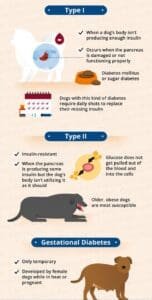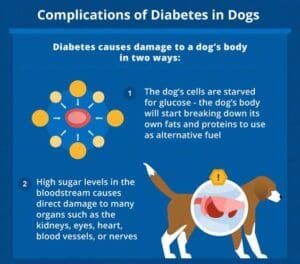Caring for a dog with diabetes can be a challenging task, but with the right knowledge and guidance, it is entirely manageable. Understanding the symptoms, implementing a specialized diet, and administering the necessary medication are all essential aspects of providing the best care for your furry friend. In this article, we will explore the various symptoms to watch out for, along with the importance of a well-balanced diet and the correct medication regimen to ensure your dog’s health and happiness. Whether you are a seasoned dog owner or a novice, this guide will equip you with the necessary tools to effectively care for your diabetic pup.
Understanding Diabetes in Dogs
Diabetes is a chronic disease that affects dogs just as it does humans. It occurs when the body fails to properly regulate blood sugar levels, resulting in too much glucose in the bloodstream. This can have serious implications for your furry friend’s health and wellbeing. Understanding the basics of diabetes in dogs is essential in order to provide the best care possible.
What is diabetes?
Diabetes is a condition that occurs when the body is unable to produce enough insulin or effectively use the insulin it does produce. Insulin is a hormone that helps regulate blood sugar levels and allows glucose to enter cells for energy. Without enough insulin or proper utilization, glucose remains in the bloodstream, causing high blood sugar levels.
Types of diabetes in dogs
There are two main types of diabetes that can affect dogs: type 1 and type 2 diabetes.
Type 1 diabetes, also known as insulin-dependent diabetes, occurs when the pancreas fails to produce enough insulin. This type of diabetes is more common in dogs and usually requires lifelong insulin therapy.
Type 2 diabetes, on the other hand, is characterized by insulin resistance. This means that the body’s cells do not respond properly to the insulin produced. Type 2 diabetes is less common in dogs compared to humans and is usually managed through dietary changes, weight management, and medication.
Causes and risk factors
The exact cause of diabetes in dogs is often unknown, but certain factors may increase the risk. Obesity, genetic predisposition, pancreatitis, autoimmune disorders, and certain medications can all contribute to the development of diabetes in dogs. It is important to be aware of these risk factors and take steps to minimize their impact on your pet’s health.
Identifying Symptoms of Diabetes in Dogs
Early detection of diabetes is vital for effective management. Being aware of the common symptoms associated with diabetes can help you identify any potential issues and seek veterinary attention promptly.
Excessive thirst and urination
One of the most noticeable symptoms of diabetes in dogs is an increased thirst and urination. When blood sugar levels are consistently high, the body tries to eliminate the excess glucose through increased urination. This results in excessive water intake, leading to frequent urination.
Increased hunger
Despite consuming more food, diabetic dogs may experience increased hunger. This is due to the body’s inability to properly utilize glucose for energy, resulting in a perceived lack of nourishment.
Weight loss
Weight loss can occur in diabetic dogs, even if they are consuming adequate amounts of food. The body’s inability to effectively use glucose forces it to break down stored fats and proteins for energy, resulting in weight loss.
Lethargy and weakness
Diabetic dogs may exhibit lethargy and weakness as a result of their body’s inability to convert glucose into energy. This can manifest as reduced activity levels and a lack of enthusiasm.
Blurred vision
Diabetes can impact your dog’s eyesight, leading to blurred vision. If you notice your furry friend bumping into objects or showing signs of impaired vision, it is important to seek veterinary attention.
Chronic infections
Diabetes weakens the immune system, making dogs more susceptible to infections. Recurrent urinary tract infections, skin infections, and slow-healing wounds may be indicators of diabetes in dogs.
Diagnosing Diabetes in Dogs
If you suspect that your dog may have diabetes based on the symptoms observed, it is crucial to consult with your veterinarian for a proper diagnosis. These professionals have the expertise and tools needed to accurately diagnose and manage diabetes in dogs.
Physical examination
During a physical examination, your veterinarian will assess your dog’s overall health and look for any physical signs of diabetes, such as weight loss, dehydration, or cataracts.
Blood and urine tests
Blood and urine tests are essential for diagnosing diabetes in dogs. These tests measure blood sugar levels and check for the presence of glucose in the urine, which can indicate diabetes.
Glycosylated hemoglobin (A1C) test
The glycosylated hemoglobin (A1C) test, commonly used in humans, can also be utilized for diagnosing diabetes in dogs. This test provides a more comprehensive view of a dog’s average blood sugar levels over the past few months.
Treating Diabetes in Dogs
Once your dog has been diagnosed with diabetes, the next step is to establish an appropriate treatment plan. Diabetes management typically revolves around insulin therapy, regular veterinary check-ups, blood glucose monitoring, exercise, weight management, and a diabetes-friendly diet.
Insulin therapy
Most dogs with diabetes require insulin injections to manage their blood sugar levels effectively. Insulin is typically administered once or twice daily, as prescribed by your veterinarian.
Administering insulin injections
Your veterinarian will demonstrate the proper technique for administering insulin injections. It is essential to ensure proper needle disposal and careful handling of the insulin to maintain its efficacy.
Monitoring blood glucose levels
Regular monitoring of your dog’s blood glucose levels is crucial for effective diabetes management. This can be done using a glucometer, which allows you to measure their blood sugar levels at home.
Regular veterinary check-ups
Regular check-ups with your veterinarian are essential to monitor your dog’s progress and make any necessary adjustments to their treatment plan. Blood and urine tests may be performed during these visits to assess their overall health and diabetes management.
Exercise and weight management
Regular exercise and weight management play a significant role in diabetes management for dogs. Ensuring your dog receives appropriate exercise and maintaining a healthy weight can help regulate blood sugar levels.
Designing a Diabetes-Friendly Diet
A balanced and nutritious diet is crucial for managing diabetes in dogs. Providing them with the right combination of nutrients while minimizing the intake of high-carbohydrate and sugary foods is essential.
Importance of a balanced diet
A balanced diet is important for dogs with diabetes to maintain stable blood sugar levels and overall health. It should consist of high-quality protein sources, healthy fats, and a controlled amount of carbohydrates.
Commercial diabetic dog food
There are specially formulated commercial diets available for dogs with diabetes. These diets are designed to provide the necessary nutrients while helping to regulate blood sugar levels and support overall health.
Home-cooked meals
If you prefer to prepare your dog’s meals at home, it is essential to consult with a veterinary nutritionist to ensure that the homemade diet meets all their nutritional requirements. A properly balanced homemade diet can be an excellent option for dogs with diabetes.
High-quality protein sources
Including high-quality protein sources in your dog’s diet is crucial. Lean meats, fish, and eggs are excellent choices that provide essential amino acids.
Low-carbohydrate options
Minimizing the intake of carbohydrates is important for managing blood sugar levels in diabetic dogs. Incorporating low-carbohydrate options, such as green leafy vegetables, into their diet can help achieve better glucose control.
Avoiding sugary treats
Sugary treats should be avoided or limited for dogs with diabetes. Opt for healthier treats that are specifically designed for diabetic dogs or consult with your veterinarian for suitable alternatives.
Managing Medication and Dosage
Proper management of medication and dosage is essential for maintaining your dog’s blood sugar levels within the target range. Understanding the different types of insulin, storage and handling requirements, and the correct dosage for your dog is key.
Types of insulin for dogs
There are different types of insulin available for dogs, including rapid-acting, short-acting, and long-acting insulin. Your veterinarian will determine the appropriate type and dosage based on your dog’s specific needs.
Proper storage and handling
Insulin should be stored properly, refrigerated as directed, and protected from direct sunlight and extreme temperatures. Always follow the instructions provided by your veterinarian or on the medication package.
Determining the right dosage
Determining the right dosage of insulin for your dog requires close collaboration with your veterinarian. Factors such as your dog’s weight, blood glucose levels, and response to the medication will influence the dosage prescribed.
Adjusting insulin doses
Insulin doses may need to be adjusted over time to achieve optimal blood sugar control. Regular monitoring, veterinary check-ups, and close communication with your veterinarian are vital for making necessary adjustments to the insulin dosage.
Recognizing and managing hypoglycemia
Hypoglycemia, or low blood sugar, can occur if the insulin dosage is too high or if your dog hasn’t eaten enough. It is important to be able to recognize the signs of hypoglycemia, such as weakness, disorientation, and seizures, and take appropriate action, such as administering a sugar-containing solution or contacting your veterinarian.
Monitoring Blood Glucose Levels
Monitoring your dog’s blood glucose levels regularly is crucial for effective diabetes management. This helps you assess their response to treatment, make necessary adjustments, and ensure their blood sugar levels remain within the target range.
Glucometers for at-home monitoring
Using a glucometer, specifically designed for veterinary use, allows you to monitor your dog’s blood glucose levels at home. Your veterinarian can provide guidance on choosing a suitable glucometer and teach you how to properly use it.
Collecting blood samples
Collecting blood samples for glucose monitoring may require a small pinprick at the dog’s ear, paw pad, or other suitable site. It is important to follow the instructions provided by your veterinarian to collect an accurate blood sample.
Interpreting blood glucose readings
Interpreting blood glucose readings can help you understand whether your dog’s blood sugar levels are within the target range. Recording these readings and sharing them with your veterinarian during check-ups can provide valuable information for adjusting the treatment plan, if necessary.
Target blood glucose range
Maintaining blood glucose levels within a target range is crucial for optimal diabetes management. The target range can vary depending on your dog’s specific needs and response to treatment. Your veterinarian will guide you on the ideal range for your dog.
Dealing with Hypoglycemia
Hypoglycemia, or low blood sugar, can be a potentially life-threatening condition for dogs with diabetes. Understanding how to recognize the signs of hypoglycemia and how to respond promptly is crucial.
Recognizing the signs of low blood sugar
Signs of hypoglycemia in dogs may include weakness, tremors, confusion, disorientation, seizures, or coma. If you suspect your dog is experiencing hypoglycemia, it is important to act quickly to prevent further complications.
Emergency treatment
In the case of hypoglycemia, providing quick and appropriate treatment is essential. Administering a sugar-containing solution, such as honey or a glucose gel, can help raise your dog’s blood sugar levels. Contacting your veterinarian for further guidance is also important.
Preventing hypoglycemia
Preventing hypoglycemia involves closely adhering to the recommended insulin dosage, ensuring your dog consumes an appropriate amount of food, and sticking to a consistent feeding schedule. Regular monitoring can also help identify any potential issues before they develop into a hypoglycemic episode.
Preventing Complications
Proper diabetes management can help prevent complications associated with diabetes in dogs. Regular veterinary check-ups, early detection of complications, and addressing specific concerns can significantly improve your dog’s quality of life.
Regular veterinary check-ups
Regular veterinary check-ups are essential to monitor your dog’s overall health and diabetes management. These visits allow your veterinarian to assess their progress, make adjustments to the treatment plan if necessary, and detect any potential complications early on.
Early detection of complications
Certain complications, such as urinary tract infections and diabetic retinopathy, can arise as a result of diabetes. Regular monitoring and prompt veterinary attention can help detect these complications early, allowing for timely intervention.
Addressing urinary tract infections
Diabetic dogs are more prone to developing urinary tract infections. If you observe symptoms such as frequent urination, blood in the urine, or accidents indoors, it is important to seek veterinary attention promptly to prevent the infection from spreading.
Caring for diabetic retinopathy
Diabetic retinopathy, a condition characterized by damage to the blood vessels in the eyes, can cause vision impairment or even blindness. Regular eye examinations by a veterinary ophthalmologist can help detect and manage this condition.
Preventing neuropathy
Diabetic neuropathy, a nerve damage associated with diabetes, can cause pain, weakness, and difficulty walking. Maintaining stable blood sugar levels, providing appropriate exercise, and monitoring for any signs of neuropathy can help prevent its onset or slow its progression.
Providing Support and Comfort
Caring for a diabetic dog involves more than just managing their medical needs. Providing a supportive and comfortable environment is crucial for their overall wellbeing.
Creating a stable routine
Establishing a stable routine can help minimize stress and anxiety for your diabetic dog. Regular meal times, insulin injections, exercise, and rest periods can provide a sense of security and promote a stable blood glucose level.
Ensuring a stress-free environment
Reducing stress in your dog’s environment is important for their overall well-being. High levels of stress can potentially impact blood sugar levels and cardiovascular health. Avoiding loud noises, minimizing changes to their routine, and providing a safe and calm space can all contribute to a stress-free environment.
Supportive care during illness
When your dog is ill or experiencing any medical concerns, providing supportive care is essential. This may involve additional monitoring, adjusting their treatment plan if necessary, or seeking immediate veterinary attention when needed.
Maintaining dental health
Good dental health is important for all dogs, including those with diabetes. Poor oral hygiene can lead to dental problems and infections, which may further impact their overall health and diabetes management. Regular teeth brushing and professional dental cleanings can help maintain your dog’s dental health.
Monitoring for signs of distress
As a caring and responsible pet owner, it is important to monitor your dog for any signs of distress or discomfort. Changes in behavior, appetite, or activity levels can be indicative of underlying issues that may require veterinary attention. Prompt intervention and addressing any concerns promptly can lead to better outcomes for your furry friend.
Caring for a dog with diabetes requires a comprehensive approach that involves understanding the disease, monitoring blood glucose levels, adhering to a proper diet, managing medication, and providing a supportive environment. By implementing these strategies and working closely with your veterinarian, you can help your dog lead a happy and healthy life despite their diabetes diagnosis.



